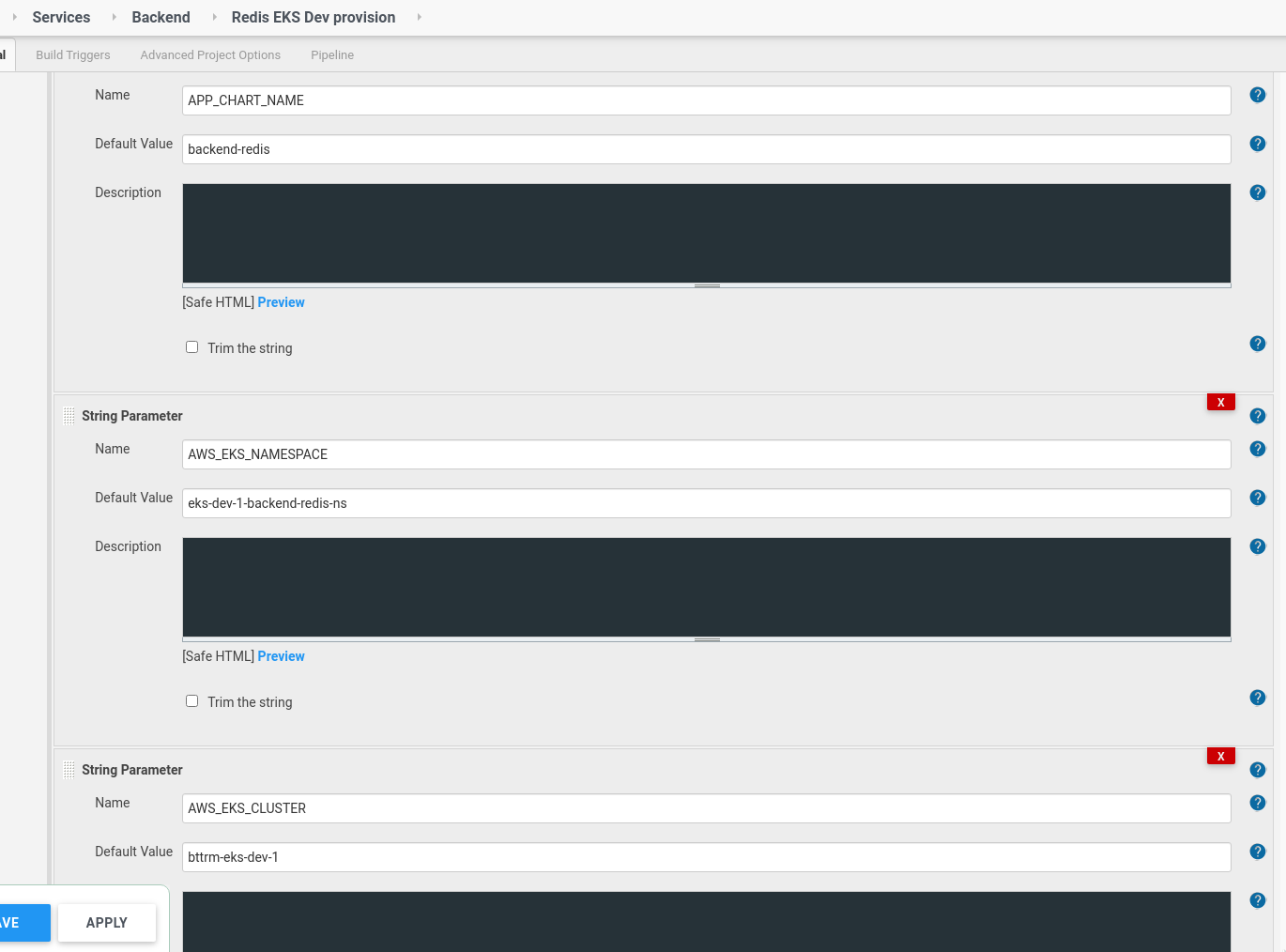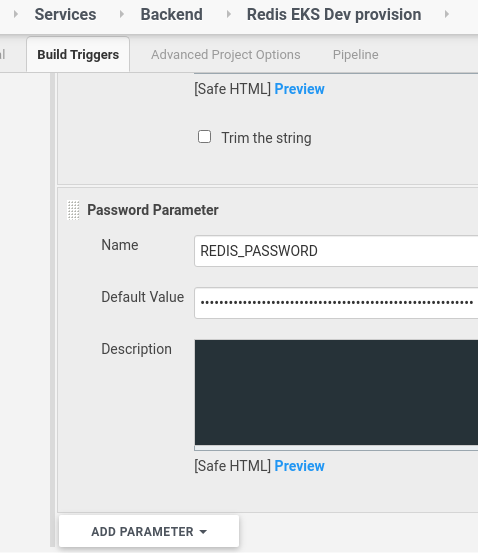 The task is to create a Jenkins job to deploy Redis to Dev/Stage/Prod Kubernetes clusters.
The task is to create a Jenkins job to deploy Redis to Dev/Stage/Prod Kubernetes clusters.
In the Redis: running Master-Slave replication in Kubernetes we did it manually to see how it’s working, now it’s time to automate it.
The main question is how to pass parameters for different environments during the deployment? I’d like to use an existing chart for Bitnami, and at the same time to deploy it from our own Helm chart with a values.yaml file fie each of the Dev/Stage/Prod environments.
Well, we still can create our Helm chart and add the Redis Bitnami chart as a Helm dependency, and pass a values.yaml from the parent chart.
The documentation is here>>>.
So, what we will do:
- the parent chart – backend-redis
- with the bitnami/redis dependency
- with the
envdirectory- with the
devcatalog- with the
values.yamlfile inside- where the Redis options will be kept
- with the
- with the
- and in Jenkins, it will be deployed as
helm install backend-redis -f env/${ENV}/values.yaml
Let’s go.
Contents
Creating parent Helm chart
In a repository with our services create a new chart:
[simterm]
$ helm create backend-redis Creating backend-redis
[/simterm]
Remove all template files – we don’t need them here:
[simterm]
$ rm -rf backend-redis/templates/*
[/simterm]
Create directories for the values.yaml:
[simterm]
$ mkdir -p backend-redis/env/{dev,stage,prod}
[/simterm]
Copy a config from the previous post (Rus):
[simterm]
$ cp ~/Temp/redis-opts.yaml backend-redis/env/dev/values.yaml
[/simterm]
Check its content:
[simterm]
$ head backend-redis/env/dev/values.yaml
global:
redis:
password: "blablacar"
metrics:
enabled: true
serviceMonitor:
enabled: true
namespace: "monitoring"
[/simterm]
Okay, just need to delete the password from here as it will be passed from a Jenkins Password parameter with the helm install --set during deployment.
Helm: a values.yaml for a subchart
Also, what do we need to change here is to add a child subchart’s name at the very beginning so we can use it with the parent’s chart and Helm will apply those values to the Redis chart from Bitnami which is our child chart.
Add the redis word to the beginning of the file and remove the password‘s value:
redis:
global:
redis:
password: ""
metrics:
enabled: true
serviceMonitor:
enabled: true
namespace: "monitoring"
master:
persistence:
enabled: false
service:
type: LoadBalancer
annotations:
service.beta.kubernetes.io/aws-load-balancer-internal: "true"
...
Now, we can add a dependency to our parent backend-redis chart, add the Redis chart:
[simterm]
$ helm search repo redis NAME CHART VERSION APP VERSION DESCRIPTION bitnami/redis 11.2.3 6.0.9 Open source, advanced key-value store. It is of... bitnami/redis-cluster 3.2.10 6.0.9 Open source, advanced key-value store. It is of... stable/prometheus-redis-exporter 3.5.1 1.3.4 DEPRECATED Prometheus exporter for Redis metrics stable/redis 10.5.7 5.0.7 DEPRECATED Open source, advanced key-value stor... stable/redis-ha 4.4.4 5.0.6 Highly available Kubernetes implementation of R... stable/sensu 0.2.3 0.28 Sensu monitoring framework backed by the Redis ...
[/simterm]
Let’s use the bitnami/redis 11.2.3, add dependencies to the Chart.yaml of the parent’s chart:
... dependencies: - name: redis version: ~11.2 repository: "@bitnami"
Add the repository:
[simterm]
$ helm repo add bitnami https://charts.bitnami.com/bitnami
[/simterm]
Run for the test:
[simterm]
$ helm install backend-redis . --dry-run -f env/dev/values.yaml --debug install.go:172: [debug] Original chart version: "" install.go:189: [debug] CHART PATH: /home/setevoy/Work/devops-kubernetes/projects/backend/services/backend-redis Error: found in Chart.yaml, but missing in charts/ directory: redis helm.go:94: [debug] found in Chart.yaml, but missing in charts/ directory: redis ...
[/simterm]
“Error: found in Chart.yaml, but missing in charts/ directory: redis” – ah, yeah, forgot. Update dependencies:
[simterm]
$ helm dependency update Hang tight while we grab the latest from your chart repositories... ...Successfully got an update from the "equinor-charts" chart repository ...Successfully got an update from the "bitnami" chart repository ...Successfully got an update from the "stable" chart repository Update Complete. ⎈Happy Helming!⎈ Saving 1 charts Downloading redis from repo https://charts.bitnami.com/bitnami Deleting outdated charts
[/simterm]
Check the subchart’s archive:
[simterm]
$ ll charts/ total 64 -rw-r--r-- 1 setevoy setevoy 64195 Oct 28 16:30 redis-11.2.3.tgz
[/simterm]
Run again:
[simterm]
$ helm install backend-redis . --dry-run -f env/dev/values.yaml --debug
[/simterm]
And if everything is good here – run the installation:
[simterm]
$ helm upgrade --install --namespace eks-dev-1-backend-redis-ns --create-namespace --atomic backend-redis . -f env/dev/values.yaml --set redis.global.redis.password=p@ssw0rd --debug history.go:53: [debug] getting history for release backend-redis Release "backend-redis" does not exist. Installing it now. install.go:172: [debug] Original chart version: "" install.go:189: [debug] CHART PATH: /home/setevoy/Work/devops-kubernetes/projects/backend/services/backend-redis client.go:108: [debug] creating 1 resource(s) client.go:108: [debug] creating 9 resource(s) wait.go:53: [debug] beginning wait for 9 resources with timeout of 5m0s wait.go:206: [debug] Service does not have load balancer ingress IP address: eks-dev-1-backend-redis-ns/backend-redis wait.go:329: [debug] StatefulSet is not ready: eks-dev-1-backend-redis-ns/backend-redis-node. 1 out of 2 expected pods have been scheduled ...
[/simterm]
Pay attention, that in the --set the password parameter also passed with the subchart’s name, and then the bloc’s name – redis.global.redis.password.
Check the services:
[simterm]
$ kk -n eks-dev-1-backend-redis-ns get svc NAME TYPE CLUSTER-IP EXTERNAL-IP PORT(S) AGE backend-redis LoadBalancer 172.20.153.106 internal-a5d0d8f5a5d4a4438a2ca06610886d2f-1400935130.us-east-2.elb.amazonaws.com 6379:30362/TCP,26379:31326/TCP 70s backend-redis-headless ClusterIP None <none> 6379/TCP,26379/TCP 70s backend-redis-metrics ClusterIP 172.20.50.77 <none> 9121/TCP 70s 9121/TCP 21s
[/simterm]
Pods:
[simterm]
$ kk -n eks-dev-1-backend-redis-ns get pod NAME READY STATUS RESTARTS AGE backend-redis-node-0 3/3 Running 0 37s backend-redis-node-1 3/3 Running 0 21s
[/simterm]
And check if Redis is working:
[simterm]
admin@bttrm-dev-app-1:~$ redis-cli -h internal-a5d0d8f5a5d4a4438a2ca06610886d2f-1400935130.us-east-2.elb.amazonaws.com -p 6379 -a p@ssw0rd info replication # Replication role:master connected_slaves:1 slave0:ip=10.3.45.195,port=6379,state=online,offset=15261,lag=1 ...
[/simterm]
Cool – now we can add a Jenkins job.
Here is everything similar to the jobs from the Helm: пошаговое создание чарта и деплоймента из Jenkins post (Rus).
Jenkins deploy job
Create a Jenkins Pipeline Job.
Parameters
Add parameters:
Тут будут:
APP_CHART_NAME: parent’s chart nameAWS_EKS_NAMESPACE: a Kubernetes Namespace to deploy toAWS_EKS_CLUSTER: a Kubernetes cluster to deploy to, also used to generate the.kube/configfor thekubectlAPP_ENV: used to substitute in thebackend-redis/env/$APP_ENV/values.yamland for theverify()function call, see the Jenkins: Scripted Pipeline – Production environment job confirmation stepAPP_REPO_URL: the chart’s repositoryAPP_REPO_BRANCH: a branch in this repository
The directories structure in our repository is the following:
[simterm]
projects/
└── backend
└── services
└── backend-redis
├── Chart.lock
├── charts
│ └── redis-11.2.3.tgz
├── Chart.yaml
├── env
│ ├── dev
│ │ └── values.yaml
│ ├── prod
│ └── stage
├── templates
└── values.yaml
[/simterm]
Create a Password Parameter with a password for Redis:
Pipeline script
And write the pipeline script:
// ask confirmation for build if APP_ENV == prod
def verify() {
def userInput = input(
id: 'userInput', message: 'This is PRODUCTION!', parameters: [
[$class: 'BooleanParameterDefinition', defaultValue: false, description: '', name: 'Please confirm you sure to proceed']
])
if(!userInput) {
error "Build wasn't confirmed"
}
}
// Add slack Notification
def notifySlack(String buildStatus = 'STARTED') {
// Build status of null means success.
buildStatus = buildStatus ?: 'SUCCESS'
def color
//change for another slack chanel
def token = 'devops-alarms-ci-slack-notification'
if (buildStatus == 'STARTED') {
color = '#D4DADF'
} else if (buildStatus == 'SUCCESS') {
color = '#BDFFC3'
} else if (buildStatus == 'UNSTABLE') {
color = '#FFFE89'
} else {
color = '#FF9FA1'
}
def msg = "${buildStatus}: `${env.JOB_NAME}` #${env.BUILD_NUMBER}:\n${env.BUILD_URL}"
slackSend(color: color, message: msg, tokenCredentialId: token)
}
node {
try {
docker.image('projectname/kubectl-aws:4.1').inside('-v /var/run/docker.sock:/var/run/docker.sock') {
stage('Verify') {
switch("${env.APP_ENV}") {
case "prod":
verify()
echo "Run job"
break;
default:
echo "Dev deploy"
break;
}
}
stage('Init') {
gitenv = git branch: '${APP_REPO_BRANCH}',
credentialsId: 'jenkins-projectname-github',
url: '${APP_REPO_URL}'
GIT_COMMIT_SHORT = gitenv.GIT_COMMIT.take(8)
RELEASE_VERSION = "${BUILD_NUMBER}"
APP_VERSION = "${BUILD_NUMBER}.${GIT_COMMIT_SHORT}"
AWS_EKS_REGION = "us-east-2"
echo "APP_VERSION: ${APP_VERSION}"
echo "RELEASE_VERSION: ${RELEASE_VERSION}"
sh "aws eks update-kubeconfig --region ${AWS_EKS_REGION} --name ${AWS_EKS_CLUSTER}"
sh "kubectl cluster-info"
sh "helm version"
sh "helm -n ${AWS_EKS_NAMESPACE} ls "
}
// install dependencies
stage("Helm dependencies") {
dir("projects/backend/services/${APP_CHART_NAME}") {
sh "helm repo add bitnami https://charts.bitnami.com/bitnami"
sh "helm dependency update"
}
}
// lint the chart
stage("Helm lint") {
dir("projects/backend/services/") {
sh "helm lint ${APP_CHART_NAME} -f ${APP_CHART_NAME}/env/${APP_ENV}/values.yaml"
}
}
// just to create --app-version
stage("Helm package") {
dir("projects/backend/services/") {
sh "helm package ${APP_CHART_NAME} --version ${RELEASE_VERSION} --app-version ${APP_VERSION}"
}
}
// --dry-run first, if OK then run install
stage("Helm install") {
dir("projects/backend/services/") {
sh "helm secrets upgrade --install --namespace ${AWS_EKS_NAMESPACE} --create-namespace --atomic ${APP_CHART_NAME} ${APP_CHART_NAME}-${RELEASE_VERSION}.tgz -f ${APP_CHART_NAME}/env/${APP_ENV}/values.yaml --set redis.global.redis.password=${REDIS_PASSWORD} --debug --dry-run"
sh "helm secrets upgrade --install --namespace ${AWS_EKS_NAMESPACE} --create-namespace --atomic ${APP_CHART_NAME} ${APP_CHART_NAME}-${RELEASE_VERSION}.tgz -f ${APP_CHART_NAME}/env/${APP_ENV}/values.yaml --set redis.global.redis.password=${REDIS_PASSWORD} --debug"
}
}
stage("Helm info") {
dir("projects/backend/services/") {
sh "helm ls -a -d --namespace ${AWS_EKS_NAMESPACE}"
sh "helm get manifest --namespace ${AWS_EKS_NAMESPACE} ${APP_CHART_NAME}"
}
}
}
// send Slack notification if Jenkins build fails
} catch (e) {
currentBuild.result = 'FAILURE'
notifySlack(currentBuild.result)
throw e
}
}
Slack notifications are described in the Jenkins: уведомление в Slack из Jenkins Scripted Pipeline post (Rus).
Run the Job:
Check the result:
[simterm]
$ helm -n eks-dev-1-backend-redis-ns ls NAME NAMESPACE REVISION UPDATED STATUS CHART APP VERSION backend-redis eks-dev-1-backend-redis-ns 2 2020-10-29 14:19:52.407047243 +0000 UTC deployed backend-redis-13 13.6da15d3e
[/simterm]
Done.







